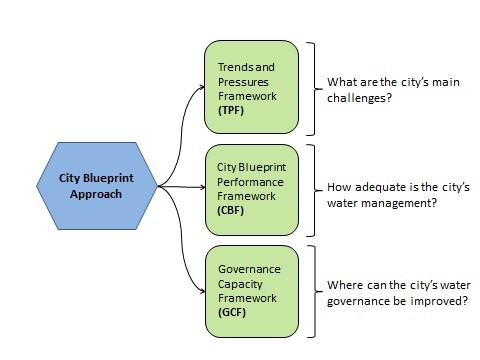
The City Blueprint Approach – Improving Implementation Capacities of Cities and Regions by sharing best practices on Urban Water Cycle Services
23 April 2018
Approximately 80% of the world’s GDP is produced, and 75% of the global energy and material flows are consumed in cities. Cities are highly dependent on other cities and hinterlands to supply materials (including water), energy, and to dispose waste. Urbanization takes place at an unprecedented rate of almost 200,000 people per day and therefore, most of our global challenges, i.e. the Sustainable Development Goals can best be addressed at the level, where these problems will concentrate: in cities (EIP Water, 2016). The City Blueprint approach provides municipalities and regions with a practical and broad framework to define steps towards realizing a more sustainable and resilient water cycle in collaboration with key stakeholders (Koop and van Leeuwen, 2017).
The City The City Blueprint® Approach is a diagnosis tool and consists of three complementary frameworks. The main challenges of cities are assessed with the Trends and Pressures Framework (TPF). How cities are managing their water cycle is done with the City Blueprint® Framework (CBF). Where cities can improve their water governance is done with the Governance Capacity Framework (GCF). The Approach has been developed by KWR Watercycle Research Institute and NetwercH2O. Detailed City Blueprint assessments have been published for cities such as Rotterdam, Dar es Salaam, Istanbul, Hamburg, Amsterdam, Ho Chi Minh City, Melbourne, Quito (Ecuador), Ahmedabad and Cape Town. Assessments have been made for more than 70 municipalities and regions in more than 30 countries (Koop and van Leeuwen, 2017).
The work on City Blueprints shows that results can be used by cities for a variety of purposes, such as enabling informed decision-making, translating knowledge and educating, and stimulating the exchange of best practices. The wide variety in the way cities deal with their water, wastewater, climate adaptation and solid waste offers key insights for improving their resilience and sustainability, provided that cities share their best practices with each other (Koop and van Leeuwen, 2017).
So far, only four cities in Africa have been assessed using the City Blueprint Approach. To address this gap and to be able to compare cities on a global scale, the City Blueprint Approach team would like to get in contact with representatives from cities in Africa.
If you are interested in learning more about the City Blueprint Approach, or if you would like to take part in the assessment for your city, please contact city.blueprint@kwrwater.nl.
For more information on the City Blueprint Approach, visit https://www.eip-water.eu/City_Blueprints.
References
- EIP Water: https://www.eip-water.eu/City_Blueprints
- Koop, S. H. A. and van Leeuwen, C. J. (2017). The challenges of water, waste and climate change in cities. Environ Dev Sustain, 19: 385-418. Available online at: https://link.springer.com/article/10.1007/s10668-016-9760-4.
- Madonsela BT, Koop SHA, Van Leeuwen CJ, Carden KJ (2019). Evaluation of Water Governance Processes Required to Transition towards Water Sensitive Urban Design—An Indicator Assessment Approach for the City of Cape Town. Water 2019, 11, 292; doi:10.3390/w11020292 https://www.mdpi.com/2073-4441/11/2/292

